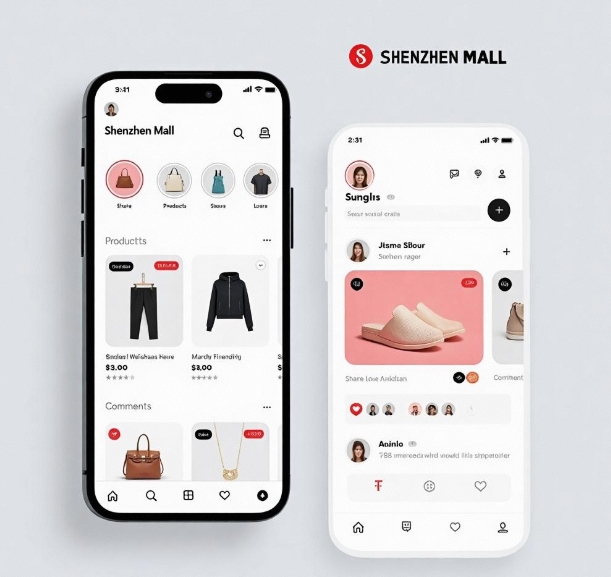Shenzhen Mall App Social E-commerce Feature Development (Group Buying/Live Streaming Sales)
- latest articles
- 1.DApp Development & Customization: Merging Diverse Market Needs with User Experience 2.Analysis of the Core Technical System in DApp Project Development 3.How to achieve cross-chain interoperability in Web3 projects? 4.How does the tokenization of points reconstruct the e-commerce ecosystem? 5.How to Set and Track Data Metrics for a Points Mall? 6.What is DApp Development? Core Concepts and Technical Analysis 7.Inventory of commonly used Web3 development tools and usage tips 8.Development of a Distribution System Integrated with Social E-commerce 9.Six Key Steps for Businesses to Build a Points Mall System 10.What is DApp Development? A Comprehensive Guide from Concept to Implementation
- Popular Articles
- 1.Future Trends and Technology Predictions for APP Development in 2025 2.Analysis of the DeFi Ecosystem: How Developers Can Participate in Decentralized Finance Innovation 3.From Zero to One: How PI Mall Revolutionizes the Traditional E-commerce Model 4.DAPP Development | Best Practices for Professional Customization and Rapid Launch 5.Recommended by the Web3 developer community: the most noteworthy forums and resources 6.From Cloud Computing to Computing Power Leasing: Building a Flexible and Scalable Computing Resource Platform 7.How to Develop a Successful Douyin Mini Program: Technical Architecture and Best Practices 8.Shared Bike System APP: The Convenient Choice in the Era of Smart Travel 9.How to Create a Successful Dating App: From Needs Analysis to User Experience Design 10.From Design to Development: The Complete Process of Bringing an APP Idea to Life
With the rapid development of internet technology, social commerce has emerged as a new business model, particularly in China, where its rise has brought significant transformations to the retail industry. Shenzhen, as a hub of technological innovation in China, is gradually becoming fertile ground for social commerce. Against this backdrop, the Shenzhen Mall App, as a key commercial platform, is actively exploring and developing social commerce features to meet the social needs of modern consumers during shopping, enhance user engagement, and drive the platform's long-term growth.
This article will start from the current state of the Shenzhen Mall App, discuss the development and application of social commerce features, analyze their impact on user experience, merchant operations, and market competition, and look ahead to future trends.
1. The Rise and Background of Social Commerce
Social commerce refers to a business model based on social networks, where product recommendations, information dissemination, and transactions occur through user social interactions. With the proliferation of mobile internet and the rise of social platforms, social commerce has gradually become a significant business domain. Compared to traditional e-commerce, social commerce places greater emphasis on trust and relationship chains between people, highlighting the use of social interactions and user sharing to increase product exposure and purchase rates.
As a leading local e-commerce platform, the Shenzhen Mall App recognizes the potential of social commerce and has begun integrating its features into the platform. Social commerce not only enhances platform activity and user engagement but also provides merchants with more precise user profiles and marketing methods.
2. Development Goals of Social Commerce Features in the Shenzhen Mall App
The core objectives of developing social commerce features in the Shenzhen Mall App primarily focus on the following aspects:
2.1 Enhancing User Engagement and Activity
Social commerce emphasizes interaction and sharing among users. By integrating social elements (such as social feeds, friend circle sharing, and social recommendations), the Shenzhen Mall App encourages users to interact and share on the platform, boosting user participation and activity. Users can interact with friends, share products, and exchange shopping experiences, which not only strengthens user engagement but also helps increase user return rates and retention.
2.2 Breaking the Limitations of Traditional E-commerce Marketing
Traditional e-commerce platforms typically rely on advertising and search engine optimization (SEO) for marketing, whereas social commerce leverages the power of social networks to overcome the limitations of traditional marketing methods. Through social recommendation algorithms, the Shenzhen Mall App makes users' purchasing behaviors, reviews, and ratings a key way for merchants and other users to learn about products. Through "interpersonal communication" and "word-of-mouth effects," social commerce helps merchants acquire targeted traffic at a lower cost.
2.3 Optimizing the Shopping Experience
Social commerce is not just about selling products but also about providing a new shopping experience. The social commerce features of the Shenzhen Mall App allow users to engage in social interactions during shopping, obtaining recommendations and reviews from friends, thereby improving the accuracy of purchasing decisions. The social shopping experience enables consumers to participate in the entire social process, enhancing the enjoyment and immersion of shopping.
3. Implementation Path of Social Commerce Features in the Shenzhen Mall App
3.1 Social Recommendation System
By integrating a social recommendation system, the Shenzhen Mall App closely links users' social relationships with product recommendations. By analyzing users' interest preferences, purchase history, and interaction data within social networks, the platform can accurately push products that meet user needs. The social recommendation system not only increases product exposure but also enhances users' trust in products, thereby promoting purchases.
3.2 Social Interaction and Sharing
The social commerce features of the Shenzhen Mall App emphasize social interaction, encouraging users to share shopping insights, product reviews, and usage experiences within the platform. Users can interact with friends through comments, likes, and shares, disseminating shopping links, coupons, and discount information to achieve a viral effect. Additionally, the platform can incentivize users to share products through mechanisms like point rewards and coupons, increasing the breadth and depth of social dissemination.
3.3 Social Live Streaming and Short Videos
With the rise of live streaming and short videos, social commerce has gradually incorporated these features into platforms. By introducing social live streaming and short video functions, the Shenzhen Mall App enables merchants and users to showcase and promote products through real-time interactions. Users can watch product introductions, participate in live interactions, and ask questions in real time, enhancing interaction and trust between users and merchants. Short video content also helps users better understand product usage scenarios and effects, boosting purchase desire.
3.4 Social Shopping Community
The social shopping community is a key component of the Shenzhen Mall App's social commerce features. By establishing dedicated shopping communities, the platform allows users to discuss products, share experiences, and recommend items to one another. Such communities not only enhance users' sense of belonging but also help the platform build a network of trust among users. Merchants can also gain insights into user needs and feedback through community interactions, optimizing products and services.
4. Impact of Social Commerce Features on Merchants
The rise of social commerce has introduced new requirements for merchants' operational methods. Traditional e-commerce models rely on platform traffic guidance, whereas social commerce depends more on user recommendations and social dissemination. After the introduction of social commerce features in the Shenzhen Mall App, merchants' operational strategies also need corresponding adjustments.
4.1 Targeted User Base
Through the analysis of social relationship chains, social commerce helps merchants obtain more precise user profiles. Merchants can target advertisements and product recommendations based on users' social relationships, interests, and consumption habits. Compared to traditional e-commerce, this approach increases ad conversion rates and reduces advertising costs.
4.2 Higher Trust and Conversion Rates
Social commerce relies on word-of-mouth传播 among users, allowing merchants to gain the trust of more potential consumers through user reviews, shares, and recommendations. Through social interactions, merchants can build closer customer relationships, enhancing users' purchase intent and conversion rates.
4.3 Reduced Marketing Costs
Traditional e-commerce marketing relies on large-scale advertising and promotional activities, whereas social commerce depends on users' social networks for low-cost dissemination. Merchants can convey product information to more potential customers through social sharing, user reviews, and social recommendations, reducing marketing costs.
5. Challenges and Prospects of Social Commerce Features
Although social commerce offers numerous opportunities for platforms and merchants, it also faces several challenges during its development.
5.1 User Privacy and Data Security
Social commerce relies on large amounts of user data for精准 recommendations and personalized services, which raises concerns about privacy and data security. When developing social commerce features, the Shenzhen Mall App must strictly comply with data protection regulations to ensure the security of users' personal information and transaction data.
5.2 Content Quality Control
Social commerce emphasizes user-generated content (UGC), such as reviews, shares, and live streams. However, the quality of user-generated content varies and can sometimes negatively impact the platform's reputation and user experience. Therefore, the Shenzhen Mall App needs to strengthen content moderation mechanisms to ensure the quality and authenticity of platform content.
5.3 Intense Market Competition
With the rise of social commerce, various platforms have launched similar features, leading to increasingly fierce market competition. The Shenzhen Mall App needs to continuously innovate and optimize its social commerce features to maintain competitiveness. At the same time, the platform must strengthen cooperation with merchants to jointly enhance user experience and create unique market advantages.
6. Conclusion
Social commerce has become a key trend in the future development of e-commerce. The exploration and practice of the Shenzhen Mall App in this field have brought new momentum to its platform growth. By continuously optimizing social commerce features and enhancing user experience, the Shenzhen Mall App can not only attract more users but also help merchants improve operational efficiency and marketing effectiveness. In the future, the Shenzhen Mall App needs to continue focusing on technological innovation, market demands, and user feedback to不断提升 the competitiveness of its social commerce features and build a richer and more efficient e-commerce ecosystem.
-

How does the tokenization of points reconstruct the e-commerce ecosystem?
With the continuous advancement of internet technology and the gradual prolifera···
-

How to Set and Track Data Metrics for a Points Mall?
With the rapid development of the e-commerce industry, points malls, as a common···
-

Development of a Distribution System Integrated with Social E-commerce
With the rapid development of internet technology, the e-commerce industry has e···

 Blockchain
Blockchain












